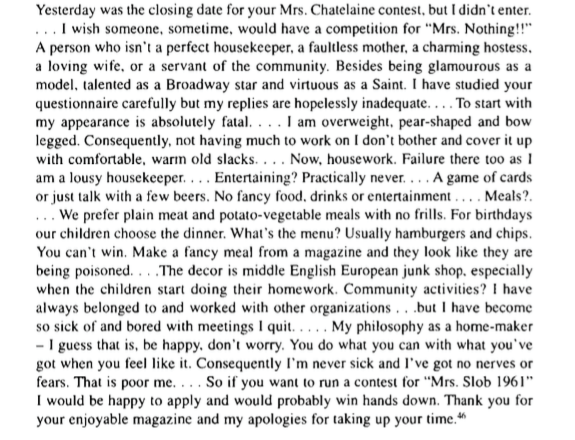I feel really guilty, like a really bad mother, when people ask me what my kids are studying at university. I only have a vague notion. I say, “Jake’s doing grad work in Theory and Criticism and Micah is going into his last year in Art History,” praying I’m not asked any follow-up questions and quickly changing the subject to climate change. I have made a few attempts to read Jake’s 2016 undergrad thesis (that he even won an award for) but it remains on my bedside table, its little spine barely cracked, providing a good remedy for insomnia. I know. I have earned my F- in “parenting.”
But things may be looking up in my level of engagement vis-a-vis my sons’ studies. Micah is home this summer and taking a requisite Canadian history course via distance learning. As he was doing homework at the dining room table yesterday, he said, “Mom, I think there may be some reading you’d be interested in.” He sent me three scholarly articles about the condition of married women in the post-war era.
Now, this is something I can totally relate to. The article I enjoyed the most is “Mrs. Chatelaine” vs. “Mrs. Slob”: Contestants, Correspondents and the Chatelaine Community in Action, 1961-1969 by Valerie J. Korinek. In 1960, Chatelaine (which was the only Canadian periodical for women at that time) launched a contest to discover “Mrs. Chatelaine”. The winner was chosen based on her detailed answers to personal questions (e.g., her weight, husband’s income, ages of kids) to more difficult essays about how she kept house, entertained, and served her church and community. Contest rules (written and un-written) barred working wives, older women, single women, lesbians, etc.
The first contest winner, announced in 1961, embodied Chatelaine’s gold standard of the Canadian wife and mother — middle-class, conservative, heterosexual. It was Mrs. Joyce Sacton from Saskatchewan who won (cash, a trip to Paris, etc.) from almost 6,000 entries. The former school teacher turned farm wife and mother of three preserved 140 quarts of fruit and vegetables each year, made her kids’ clothes as well as her own, ran a community swim program and was actively involved in nine other community groups.
While many women celebrated Chatelaine’s definition of femininity, others begged to differ. The letter that created traction for an alternate definition of the role of women in post-war society — including the limits of suburbia and the sexual status quo — was written by Mrs. Beatrice Maitland from New Brunswick. You will enjoy her letter:
While Chatelaine never did introduce a contest for “Mrs. Slob,” Maitland’s letter encouraged other women to write in and lend their support in solidarity. It was a wake-up call for Chatelaine and they modified their criteria for their poster woman. It is doubtful that a working wife and mother would have won in 1969 if it wasn’t for the humourous yet compelling argument made by Mrs. Maitland.
In fairness to Chatelaine they also ran articles in the 1960s that examined social issues and sexism. Their then-editor, the iconic Doris Anderson, wrote feminist pieces such as: “Some women just aren’t cut out to be mothers.”
I’ve wondered that about myself sometimes. But I’m definitely feeling better about my efforts now.
Photo credit: Flickr-Classic Film
Previous: My Riverdale: New York CafeNext: Vacationing with your Partner’s Parents? 3 Ways to Make a Great Impression



eden baylee
Jun 22, 2017 -
Haha Sue, I love your take on this. Having known you for a while now, I’d say you are FAR from being “Mrs. Slob.”
It could not have been easy to step out of perceived norms in the sixties, especially when THE one Canadian magazine for women dictated their ideal wife/mother. Women today see themselves as the subject of numerous periodicals — as if these zines were the “How to” manuals for all we should be –how we should dress, put on make-up, basically — how we should look, overall. It’s subtler today, and women are no longer seen as one-dimensional, but there is still a undercurrent of what is considered ‘ideal.’
Whether she knew it or not at the time, Ms. Maitland moved the needle for women, and she did it with grace and humour.
Great piece!
eden
Sue Nador
Jun 22, 2017 -
Oh, I think you might change your opinion if you just dropped in for a surprise visit!!! It is so hard not to “compare” ourselves to other women, see how we measure (or don’t measure up). I love the unapologetic and confidently self-deprecating way Maitland set the bar on the height she wanted it. I bet her kids turned out better than all right! Thanks so much for the generous comments, Eden!!! xo